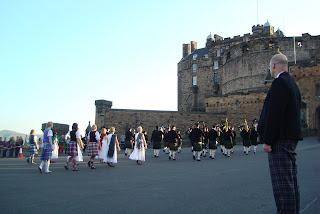 We thought it might be a good idea to publish mini "profiles" of members of the Scottish Military Research Group. That way you get to know a little more about us, what our interests are, and what we're all about. The first "volunteer" is Adam Brown, who some of you may know is one of the administrators of the Group. Together with myself we are responsible for the running of the two main Projects (War Memorials and War Graves) and here Adam explains where his interest in all things military came from.
We thought it might be a good idea to publish mini "profiles" of members of the Scottish Military Research Group. That way you get to know a little more about us, what our interests are, and what we're all about. The first "volunteer" is Adam Brown, who some of you may know is one of the administrators of the Group. Together with myself we are responsible for the running of the two main Projects (War Memorials and War Graves) and here Adam explains where his interest in all things military came from.I am the wrong side of forty and as far back as I can remember I have been interested in military history. It's a long story but I think I can trace it all back to a pack of 1/32
nd Airfix British Paratroops given to me when I was about five. I'll not bore you with all the details but thanks to
Airfix models, 'Commando' books, and the 'Victor' and 'Battle' comics by the time I was a ten I was daft on the Second World War.
As a teenager my horizons were broadened by 'O' Grade and Higher History topics on the First World War and Nineteenth Century European revolutions and
unifications. I also started putting together my own very modest collection of reference books. Growing up in East Sutherland meant any trip to
Inverness included a trip to
Melven's Bookshop in Union Street which always had a selection of Osprey Men-at-Arms books which were within my pocket money budget.
My student years and the years just after that were not years of plenty so book purchases tended to be from charity shops or car boot sales but it did mean I broadened my horizons further and I would read just about anything on military subjects from the Ancients up until the Falklands and First Gulf war.
That eclectic range of military subjects continues to this day and recent books on my reading pile have included books on Robert the Bruce, the Atlantic Campaign 1939-45, Earl
Haig, The Berlin Wall, US Army forts in the 'Wild' West, Maps of Europe 1789 - 1914, and for light relief - Bernard
Cornwell's "The Fort". I also subscribe to the BBC History magazine so I've always got a copy of that handy to dip in to.
I can probably trace my interest in war memorials back to the early 1990s. It was then that I first transcribed the names on my local memorial in
Brora and started to try and find something about them. I was living 250 miles away from the memorial so I was a regular visitor to the Edinburgh Central Library to pour through old copies of Soldiers Died in the Great War and the
CWGC registers. I was young, free and single and living in the
Lawnmarket at the time so could visit the library every evening. There was no electronic searches in those days, I just scanned each dusty page looking for a name or a place name. As I came across another local town or place in an entry I would note the name and details down and before I knew it I was researching all the other memorials in Sutherland too. I'm not a genealogist, that doesn't interest me greatly but I am a 'delver'. I like looking through databases and registers and spent many happy hours in the back of the Central Reference Library before home
PCs, CD-Roms and the
internet changed the way I approached my hobby.
It wasn't just an interest in the names on a memorial though, it was an interest in the memorials as well. Perhaps the statues remind me of the
Airfix soldiers from my childhood? Who knows. I guess when it comes down to it like most British males I'm a bit of an anorak but instead of trains or birds I happen to be a war memorial spotter!











